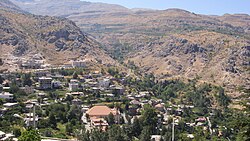Tannourine
|
Tannourine تنورين |
|
|---|---|
| City | |

Tannourine
|
|
| Coordinates: 34°11′00″N 35°54′11″E / 34.18333°N 35.90306°E | |
| Area | |
| • Total | 92 km2 (36 sq mi) |
| Population (2015) | |
| • Total | 16,000 |
| Time zone | Asia/Beirut (UTC+2) |
| • Summer (DST) | +3 (UTC) |
| Area code(s) | +961 (06) |
Tannourine (also Tannoureen, Tannorine, in Arabic تنورين) is a Lebanese municipality located in the Batroun District, part of the Mohafazah (Governorate) of North-Lebanon, 75 km from the capital Beirut. Tannourine’s name stems from the town's geography, which resemble the convex form of an oven called the tannoor. The "ine" is probably in proportion to the presence of 2 areas that make up this town, the Lower Tannourine and the upper Tannourine areas.
Tannourine is the plural of the Syriac word Tannour. A Tannour is an old stone oven used in ancient times. The very first settlers established a number of Tannours in Tannourine-Al-Fawqa, and later settled down the valley in Tannourine-Al-Tahta, where a more fertile landscape allowed local agriculture to thrive.
Tannourine lies in a collection of valleys and ravines accessible either from Douma, Kfour Al Arbe, a backroad from Bsharri or from a newly constructed highway direct from Batroun.
The village also shares its name with a cedar forest of some 60,000 trees, making it the largest cedar reserve in Lebanon. The landscape overlooking the historic valley of Ain-Al-Raha is ideal for the culture of cedars, which grow in abundance. These cedars can be seen along the road that goes north to Hadath al-Jebbeh, which, although in poor condition, winds its way through wild and isolated scenery up to the Kadisha Valley gorge, leading to Bsharri.
Other companion trees like Cupressus, Pinus, Abies, Populus and others constitute a very rich ecosystem in planter species. The fauna described as being present in this type of unique ecosystem range from the various types of birds (eagles, owls, robins, etc...) to wild animals (hyenas, boars, squirrels, snakes and bats).
The Village of Balaa (bordering Laqlouq) is known for its deep natural sink hole. A 300-meter walk brings you to a dizzying open cavern some 250 meters deep. Three natural bridges - of which the middle one is the most spectacular - complete the scene. In the spring, snow melt water forms the scenic 90m high Baatara gorge waterfall.
...
Wikipedia

